Sam Snodgrass
modl.ai
Human-like Bots for Tactical Shooters Using Compute-Efficient Sensors
Dec 30, 2024



Abstract:Artificial intelligence (AI) has enabled agents to master complex video games, from first-person shooters like Counter-Strike to real-time strategy games such as StarCraft II and racing games like Gran Turismo. While these achievements are notable, applying these AI methods in commercial video game production remains challenging due to computational constraints. In commercial scenarios, the majority of computational resources are allocated to 3D rendering, leaving limited capacity for AI methods, which often demand high computational power, particularly those relying on pixel-based sensors. Moreover, the gaming industry prioritizes creating human-like behavior in AI agents to enhance player experience, unlike academic models that focus on maximizing game performance. This paper introduces a novel methodology for training neural networks via imitation learning to play a complex, commercial-standard, VALORANT-like 2v2 tactical shooter game, requiring only modest CPU hardware during inference. Our approach leverages an innovative, pixel-free perception architecture using a small set of ray-cast sensors, which capture essential spatial information efficiently. These sensors allow AI to perform competently without the computational overhead of traditional methods. Models are trained to mimic human behavior using supervised learning on human trajectory data, resulting in realistic and engaging AI agents. Human evaluation tests confirm that our AI agents provide human-like gameplay experiences while operating efficiently under computational constraints. This offers a significant advancement in AI model development for tactical shooter games and possibly other genres.
Procedural Content Generation via Knowledge Transformation (PCG-KT)
May 01, 2023



Abstract:We introduce the concept of Procedural Content Generation via Knowledge Transformation (PCG-KT), a new lens and framework for characterizing PCG methods and approaches in which content generation is enabled by the process of knowledge transformation -- transforming knowledge derived from one domain in order to apply it in another. Our work is motivated by a substantial number of recent PCG works that focus on generating novel content via repurposing derived knowledge. Such works have involved, for example, performing transfer learning on models trained on one game's content to adapt to another game's content, as well as recombining different generative distributions to blend the content of two or more games. Such approaches arose in part due to limitations in PCG via Machine Learning (PCGML) such as producing generative models for games lacking training data and generating content for entirely new games. In this paper, we categorize such approaches under this new lens of PCG-KT by offering a definition and framework for describing such methods and surveying existing works using this framework. Finally, we conclude by highlighting open problems and directions for future research in this area.
* 15 pages, 14 figures
Deep Learning for Procedural Content Generation
Oct 09, 2020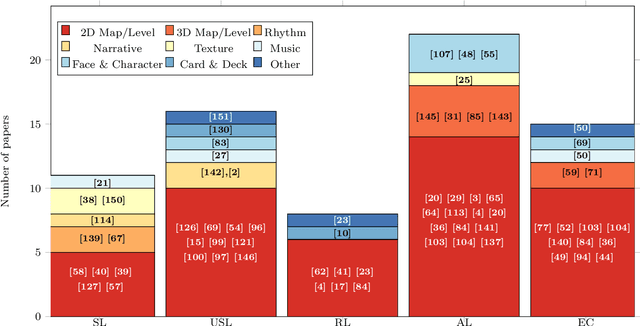
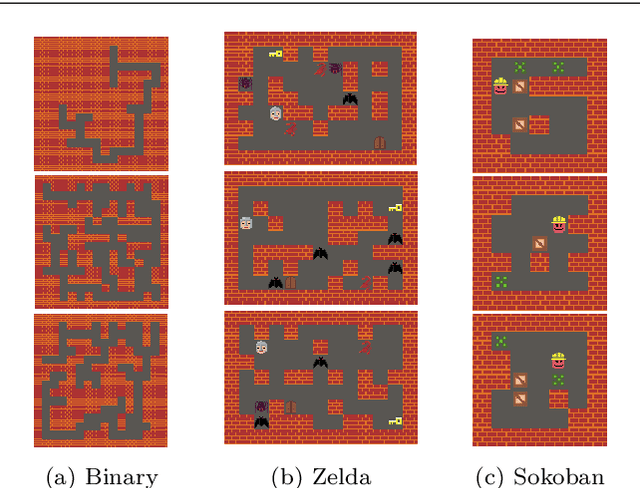
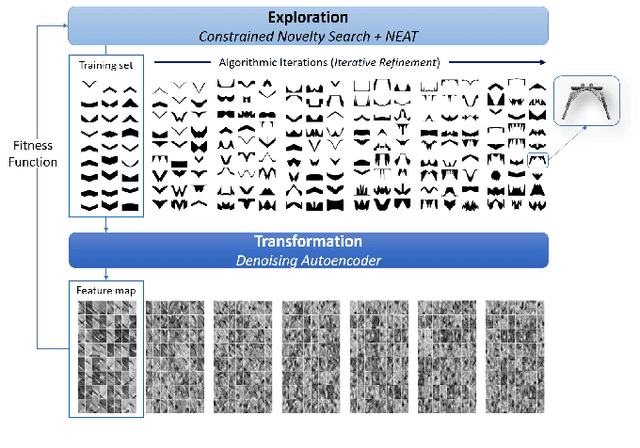
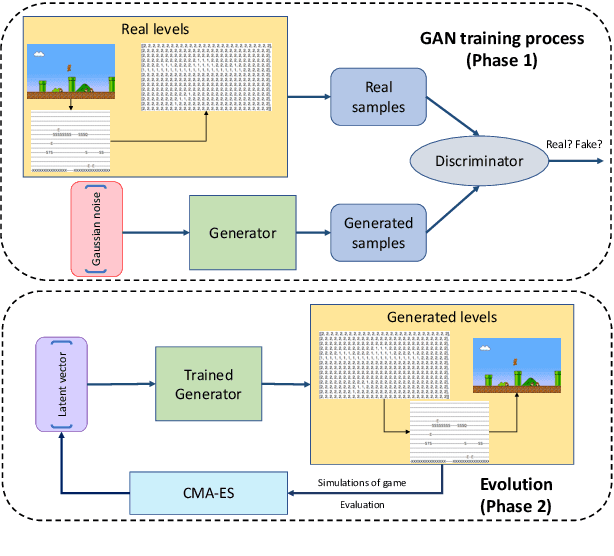
Abstract:Procedural content generation in video games has a long history. Existing procedural content generation methods, such as search-based, solver-based, rule-based and grammar-based methods have been applied to various content types such as levels, maps, character models, and textures. A research field centered on content generation in games has existed for more than a decade. More recently, deep learning has powered a remarkable range of inventions in content production, which are applicable to games. While some cutting-edge deep learning methods are applied on their own, others are applied in combination with more traditional methods, or in an interactive setting. This article surveys the various deep learning methods that have been applied to generate game content directly or indirectly, discusses deep learning methods that could be used for content generation purposes but are rarely used today, and envisages some limitations and potential future directions of deep learning for procedural content generation.
* This is a pre-print of an article published in Neural Computing and Applications. The final authenticated version is available online at: https://doi.org/10.1007/s00521-020-05383-8
Exploring Level Blending across Platformers via Paths and Affordances
Aug 22, 2020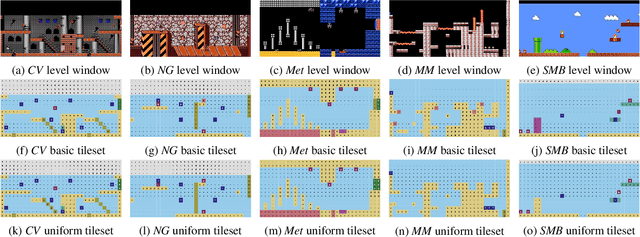
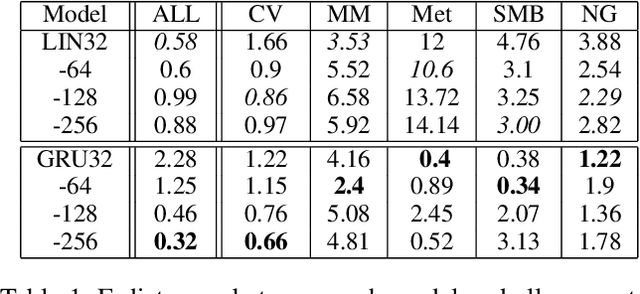


Abstract:Techniques for procedural content generation via machine learning (PCGML) have been shown to be useful for generating novel game content. While used primarily for producing new content in the style of the game domain used for training, recent works have increasingly started to explore methods for discovering and generating content in novel domains via techniques such as level blending and domain transfer. In this paper, we build on these works and introduce a new PCGML approach for producing novel game content spanning multiple domains. We use a new affordance and path vocabulary to encode data from six different platformer games and train variational autoencoders on this data, enabling us to capture the latent level space spanning all the domains and generate new content with varying proportions of the different domains.
Multi-Domain Level Generation and Blending with Sketches via Example-Driven BSP and Variational Autoencoders
Jun 17, 2020

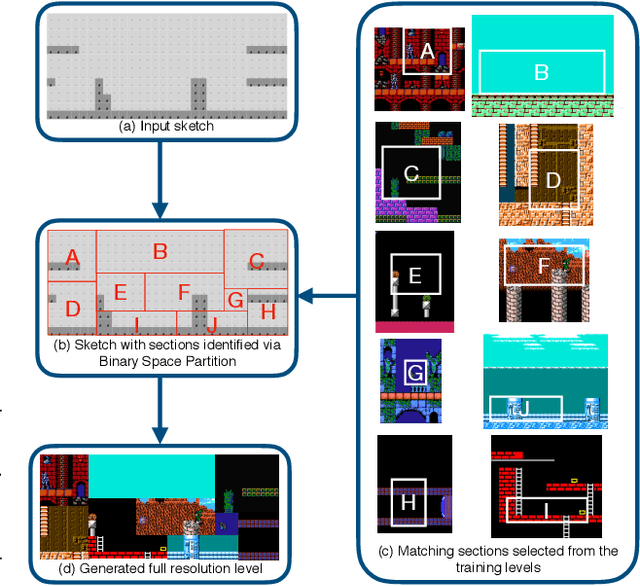
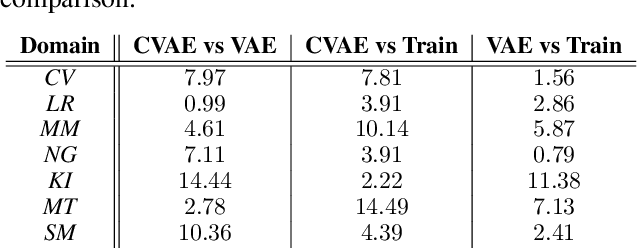
Abstract:Procedural content generation via machine learning (PCGML) has demonstrated its usefulness as a content and game creation approach, and has been shown to be able to support human creativity. An important facet of creativity is combinational creativity or the recombination, adaptation, and reuse of ideas and concepts between and across domains. In this paper, we present a PCGML approach for level generation that is able to recombine, adapt, and reuse structural patterns from several domains to approximate unseen domains. We extend prior work involving example-driven Binary Space Partitioning for recombining and reusing patterns in multiple domains, and incorporate Variational Autoencoders (VAEs) for generating unseen structures. We evaluate our approach by blending across $7$ domains and subsets of those domains. We show that our approach is able to blend domains together while retaining structural components. Additionally, by using different groups of training domains our approach is able to generate both 1) levels that reproduce and capture features of a target domain, and 2) levels that have vastly different properties from the input domain.
Capturing Local and Global Patterns in Procedural Content Generation via Machine Learning
May 26, 2020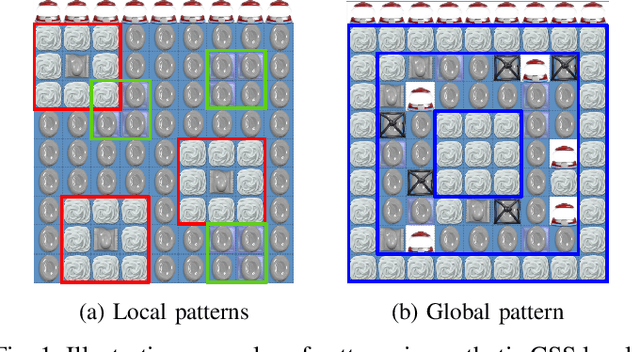
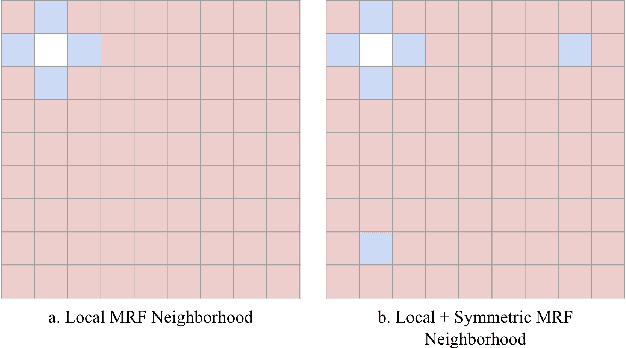
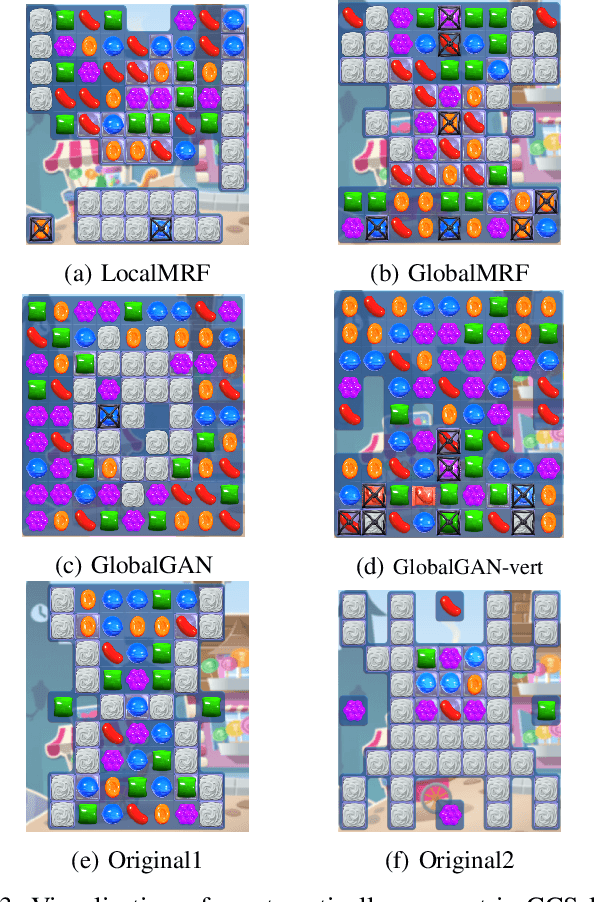
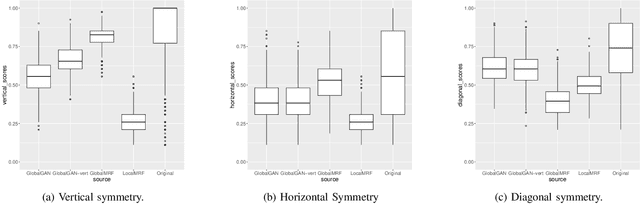
Abstract:Recent procedural content generation via machine learning (PCGML) methods allow learning from existing content to produce similar content automatically. While these approaches are able to generate content for different games (e.g. Super Mario Bros., DOOM, Zelda, and Kid Icarus), it is an open questions how well these approaches can capture large-scale visual patterns such as symmetry. In this paper, we propose match-three games as a domain to test PCGML algorithms regarding their ability to generate suitable patterns. We demonstrate that popular algorithm such as Generative Adversarial Networks struggle in this domain and propose adaptations to improve their performance. In particular we augment the neighborhood of a Markov Random Fields approach to not only take local but also symmetric positional information into account. We conduct several empirical tests including a user study that show the improvements achieved by the proposed modifications, and obtain promising results.
Procedural Content Generation via Machine Learning (PCGML)
May 07, 2018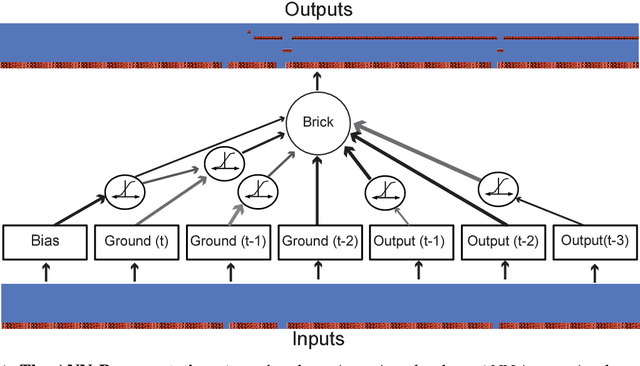

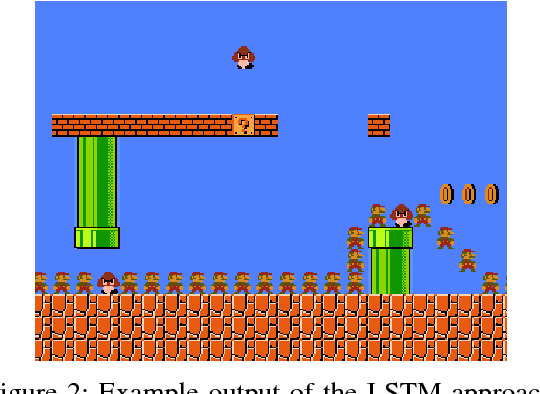
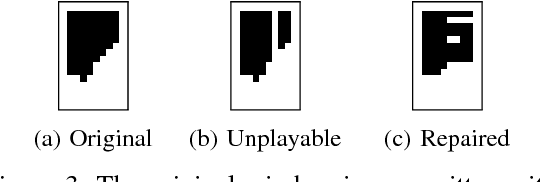
Abstract:This survey explores Procedural Content Generation via Machine Learning (PCGML), defined as the generation of game content using machine learning models trained on existing content. As the importance of PCG for game development increases, researchers explore new avenues for generating high-quality content with or without human involvement; this paper addresses the relatively new paradigm of using machine learning (in contrast with search-based, solver-based, and constructive methods). We focus on what is most often considered functional game content such as platformer levels, game maps, interactive fiction stories, and cards in collectible card games, as opposed to cosmetic content such as sprites and sound effects. In addition to using PCG for autonomous generation, co-creativity, mixed-initiative design, and compression, PCGML is suited for repair, critique, and content analysis because of its focus on modeling existing content. We discuss various data sources and representations that affect the resulting generated content. Multiple PCGML methods are covered, including neural networks, long short-term memory (LSTM) networks, autoencoders, and deep convolutional networks; Markov models, $n$-grams, and multi-dimensional Markov chains; clustering; and matrix factorization. Finally, we discuss open problems in the application of PCGML, including learning from small datasets, lack of training data, multi-layered learning, style-transfer, parameter tuning, and PCG as a game mechanic.
The VGLC: The Video Game Level Corpus
Jul 03, 2016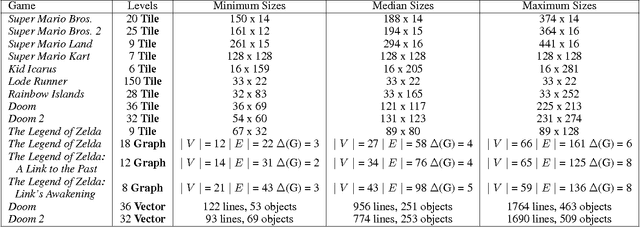

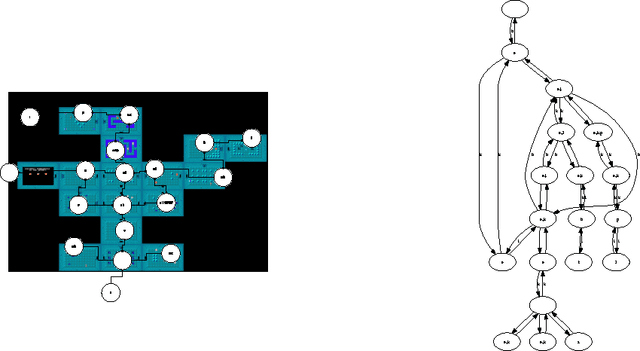

Abstract:Levels are a key component of many different video games, and a large body of work has been produced on how to procedurally generate game levels. Recently, Machine Learning techniques have been applied to video game level generation towards the purpose of automatically generating levels that have the properties of the training corpus. Towards that end we have made available a corpora of video game levels in an easy to parse format ideal for different machine learning and other game AI research purposes.
 Add to Chrome
Add to Chrome Add to Firefox
Add to Firefox Add to Edge
Add to Edge